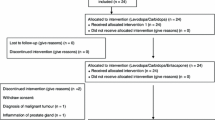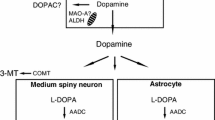Abstract
Background
The pressor effect of l-threo-3,4-dihydroxyphenylserine (L-DOPS, droxidopa, Northera™) results from conversion of L-DOPS to norepinephrine (NE) in cells expressing l-aromatic-amino-acid decarboxylase (LAAAD). After L-DOPS administration the increase in systemic plasma NE is too small to explain the increase in blood pressure. Renal proximal tubular cells abundantly express LAAAD. Since NE generated locally in the kidneys could contribute to the pressor effect of L-DOPS, in this study we assessed renal conversion of L-DOPS to NE.
Methods
Ten patients who were taking L-DOPS for symptomatic orthostatic hypotension had blood and urine sampled about 2 h after the last L-DOPS dose. L-DOPS and NE were assayed by alumina extraction followed by liquid chromatography with electrochemical detection. Data were compared in patients off vs. on levodopa/carbidopa.
Results
In patients off levodopa/carbidopa the ratio of NE/L-DOPS in urine averaged 63 times that in plasma (p = 0.0009 by t test applied to log-transformed data). In marked contrast, in the three patients on levodopa/carbidopa the ratio of NE/L-DOPS in urine did not differ from that in plasma.
Conclusion
There is extensive renal production of NE from L-DOPS. Carbidopa seems to attenuate the conversion of L-DOPS to NE in the kidneys. Further research is needed to assess whether the proposed paracrine effect of L-DOPS in the kidneys contributes to the systemic pressor response.


Similar content being viewed by others
References
Akizawa T, Koshikawa S, Iida N, Marumo F, Akiba T, Kawaguchi Y, Imada A, Yamazaki C, Suzuki M, Tubakihara Y (2002) Clinical effects of l-threo-3,4-dihydroxyphenylserine on orthostatic hypotension in hemodialysis patients. Nephron 90:384–390
Arnold AC, Okamoto LE, Gamboa A, Shibao C, Raj SR, Robertson D, Biaggioni I (2013) Angiotensin II, independent of plasma renin activity, contributes to the hypertension of autonomic failure. Hypertension 61:701–706
Biaggioni I, Freeman R, Mathias CJ, Low P, Hewitt LA, Kaufmann H (2015) Randomized withdrawal study of patients with symptomatic neurogenic orthostatic hypotension responsive to droxidopa. Hypertension 65:101–107
Biaggioni I, Garcia F, Inagami T, Haile V (1993) Hyporeninemic normoaldosteronism in severe autonomic failure. J Clin Endocrinol Metab 76:580–586
Biaggioni I, Robertson D (1987) Endogenous restoration of noradrenaline by precursor therapy in dopamine-beta-hydroxylase deficiency. Lancet 2:1170–1172
Davidson DF, Grosset K, Grosset D (2007) Parkinson’s disease: the effect of L-dopa therapy on urinary free catecholamines and metabolites. Ann Clin Biochem 44:364–368
Goldstein DS (2006) L-Dihydroxyphenylserine (L-DOPS): a norepinephrine prodrug. Cardiovasc Drug Rev 24:189–203
Goldstein DS, Holmes C, Sewell L, Pechnik S, Kopin IJ (2011) Effects of carbidopa and entacapone on the metabolic fate of the norepinephrine prodrug L-DOPS. J Clin Pharmacol 51:66–74
Hauser RA, Hewitt LA, Isaacson S (2014) Droxidopa in patients with neurogenic orthostatic hypotension associated with Parkinson’s disease (NOH306A). J Parkinsons Dis 4:57–65
Holmes C, Eisenhofer G, Goldstein DS (1994) Improved assay for plasma dihydroxyphenylacetic acid and other catechols using high-performance liquid chromatography with electrochemical detection. J Chromatogr B Biomed Appl 653:131–138
Holmes C, Whittaker N, Heredia-Moya J, Goldstein DS (2010) Contamination of the norepinephrine prodrug droxidopa by dihydroxyphenylacetaldehyde. Clin Chem 56:832–838
Johns EJ, Kopp UC, DiBona GF (2011) Neural control of renal function. Compr Physiol 1:731–767
Kagedal B, Goldstein DS (1988) Catecholamines and their metabolites. J Chromatogr 429:177–233
Kaufmann H, Freeman R, Biaggioni I, Low P, Pedder S, Hewitt LA, Mauney J, Feirtag M, Mathias CJ (2014) Droxidopa for neurogenic orthostatic hypotension: a randomized, placebo-controlled, phase 3 trial. Neurology 83:328–335
Kaufmann H, Norcliffe-Kaufmann L, Palma JA (2015) Droxidopa in neurogenic orthostatic hypotension. Expert Rev Cardiovasc Ther 13:875–891
Kaufmann H, Saadia D, Voustianiouk A, Goldstein DS, Holmes C, Yahr MD, Nardin R, Freeman R (2003) Norepinephrine precursor therapy in neurogenic orthostatic hypotension. Circulation 108:724–728
Kong J, Davies M, Mount P (2018) The importance of residual kidney function in haemodialysis patients. Nephrology (Carlton, Vic.). https://doi.org/10.1111/nep.13427
Nutt JG, Woodward WR, Anderson JL (1985) The effect of carbidopa on the pharmacokinetics of intravenously administered levodopa: the mechanism of action in the treatment of parkinsonism. Ann Neurol 18:537–543
Siirtola T, Sonninen V, Rinne UK (1975) Urinary excretion of monoamines and their metabolites in patients with Parkinson’s disease. Response to long-term treatment with levodopa alone or in combination with a dopa decarboxylase inhibitor and clinical correlations. Clin Neurol Neurosurg 78:77–88
Funding
The research reported here was supported by the Division of Intramural Research, National Institute of Neurological Disorders and Stroke, National Institutes of Health.
Author information
Authors and Affiliations
Corresponding author
Ethics declarations
Conflict of interest
On behalf of all authors, the corresponding author states that there is no conflict of interest.
Rights and permissions
About this article
Cite this article
Lamotte, G., Holmes, C., Sullivan, P. et al. Substantial renal conversion of l-threo-3,4-dihydroxyphenylserine (droxidopa) to norepinephrine in patients with neurogenic orthostatic hypotension. Clin Auton Res 29, 113–117 (2019). https://doi.org/10.1007/s10286-018-0564-5
Received:
Accepted:
Published:
Issue Date:
DOI: https://doi.org/10.1007/s10286-018-0564-5




